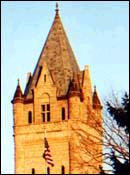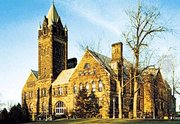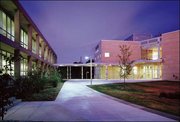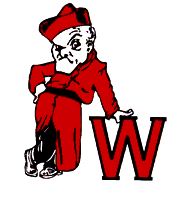Ohio Wesleyan University
|
|
| Missing image Owuseal.jpg
| |
| Motto: In lumine tuo videbimus lumen : "In Your Light We Shall See the Light" Seal's Inscription: Wesleiana Universitas Ohioensis Delawarensi : "Wesleyan University in Delaware, Ohio" | |
| Founded | 1842 |
| School type | Private coeducational liberal arts |
| President | Mark Huddleston |
| Location | Delaware, Ohio |
| Enrollment | 1,950 undergraduates |
| Endowment | $150 million |
| Campus surroundings | Suburban |
| Campus size | 200 acres (0.8 km²) (main campus) |
| Sports teams |  The Wesleyan Battling Bishops </small> |
Ohio Wesleyan University (also Wesleyan or OWU) is a private, independent, coeducational, selective liberal arts college located in Delaware, Ohio (population 26,000), 20 miles north of Columbus, Ohio, the capital of the state of Ohio in the United States and is easily accessible by car, plane, bus or train.
Wesleyan is a member of the Great Lakes Colleges Association, The Oberlin Group and the Five Colleges of Ohio,a consortium of liberal arts colleges in Ohio: Kenyon College, Oberlin College, College of Wooster and Denison University. Ohio Wesleyan University is now independent and makes no religious demands on its students. Students come from about 44 states and about 47 foreign nations.
Ohio Wesleyan University's charter provides that "the University is forever to be conducted on the most liberal principles"Template:Ref. Various college publications such as Loren Pope's, Barron's, Princeton Review and the U.S. News and World Report place Wesleyan in the top ranks of private liberal arts colleges in the United States for 2005. Ohio Wesleyan is also one of the most gay-friendly liberal arts colleges in the U.S. actively recruiting students from the LGBT populationTemplate:Ref.
The student body is approximately 75 percent Caucasian, 10 percent Asian, 6 percent Hispanic, and 9 percent black. The school's newspaper is The Transcript; the yearbook is Le Bijou. The most popular majors at Wesleyan are Economics, Political science, Psychology and English literature.Template:Ref
| Contents |
|
|
History
Sulphursprings.jpg
The roots of Wesleyan reach back to 1841 when Adam Poe and Charles Elliott, leaders of the local Williams Street Methodist Church and residents of Delaware, Ohio agreed on the need to establish a university "of the highest order"Template:Ref in central Ohio.
When the Mansion House Hotel went on the market later during the same year, Adam Poe, a resident in Delaware, Ohio, encouraged citizens of Delaware to purchase the property. Later, 172 citizens raised a $10,000 contribution and purchased it.
However, it wasn't until 1844 when Wesleyan opened its doors as a Methodist-related but nonsectarian college. In the 19th century, Ohio Wesleyan University consisted of several schools: a College of Liberal Arts (founded in 1844), a School of Oratory (founded in 1894), a School of Music (founded in 1877), a School of Fine Arts (established in 1877) and a Business School (established in 1895). The university is one of the first universities named for John Wesley, and is among the oldest of the numerous Methodist universities in the U.S. and abroad. In 1850, four young women matriculated for the regular college course at the Ohio Wesleyan Female College. Three of the four graduated in 1854 and became the first women in America to receive AB degrees.
WesleyanGrayChapel.jpg
In the early days of the college, Ohio Wesleyan University presidents were frequently nationally vocal in political debates of their times. The issues in the 1850s centered on slavery and the expansion of the United States. The fledgling Republican party, at that time associated with a more progressive platform, was organized in opposition to slavery. It was newly constituted and unrelated to earlier parties bearing the name “Republican” and they were the antecedents to today’s Democratic party. At particular issue was the idea of extending slavery into the Kansas and Nebraska and the Ohio Wesleyan new Republicans were strongly opposed. Edward Thompson, president of Ohio Wesleyan University in 1857, was vocal in the national political debate and denounced the argument that southern Christians “should retain their slaves in obedience to state laws forbidding manumission” and "The soft and slippered Christianity which disturbs no one, is not the Christianity of Christ"Template:Ref.
The college was originally an all-male institution, but it became coeducational in 1877. Wesleyan's traditions date back to its founding, when the College of Liberal Arts opened its doors with an enrollment of 29 male students taught by three professors. The college was housed in Elliott Hall, formerly the Mansion House Hotel, which had been constructed in the early 1830s when the current East Campus was a popular health resort. The resort was known for the “health-giving although odoriferous waters” of its famed Sulphur Spring, a favorite spot of future generations of students.
The Ohio Wesleyan Female College was established in 1853. In 1857, the female college moved to Monnett Hall, named for school benefactress Mary Monnett Bain. In 1877 the Ohio Wesleyan Female College was merged with the University and became coeducational. Monnett Hall remained the center for women's housing on campus well into the twentieth century.
General Information
Beeghly.jpg
Ohio Wesleyan is a liberal arts college with a population of approximately 1,900 students. The university defines itself as a "community of teachers and students devoted to the free pursuit of truth," and states a goal of developing in its students "qualities of intellect and character that will be useful no matter what they choose to do in later life and liberate them from a narrow perspective of gender, race, ethnicity and sexual orientation in every discipline".
Wesleyan's campus is located near the downtown of Delaware, Ohio and is bisected by Sandusky Street, the main north/south street through the heart of the city. The street informally divides the campus into east and west sectors, the west sector of mostly residential and adminitrative buildings and and the east one consisting of mostly academic buildings.
University Hall (see image below), a multi-use building, is one of the most notable landmark buildings on campus.
Wesleyan's main library is The Leon A. Beeghly Library housing a collection of more than 480,000 items, including rare books, manuscripts, art, microfilm, and federal government publications. Its Audio Visual Center includes a learning laboratory, multimedia classrooms, and individual viewing/listening rooms. The balance of the collection is in two other libraries elsewhere on campus (the science library in the Science Center and the music library in the Sanborn Building).
The Richard M. Ross Art Museum was acquired in 1969. Over the years the museum's collection has been carefully developed through purchases and gifts. The collection ranges from the Ohio Wesleyan University Permanent Collection as well as rotating exhibits. The collection is particularly strong in European art of the late 19th and early 20th centuries; contemporary American art; and Old Master and Japanese prints.
Ohio Wesleyan University owns The Perkins Observatory, which is located south of the city of Delaware. The observatory houses the Perkins Telescope which in 1931, the year of its completion, was the third largest in the world only after the 100 inch at Mt. Wilson, California, and the 72 inch at Victoria, B.C., Canada. The grounds near Perkins also housed Ohio State's radio telescope, known locally as The Big Ear; the Big Ear was disassembled in 1998.Several of the campus buildings are listed on the National Register of Historic Places: Austin Manor, Edwards Gymnasium, Elliott Hall, Merrick Hall, Perkins Astronomical Observatory, Sanborn Hall, Slocum Hall, Sturges Hall, Stuyvesant Hall and The University Hall.
Wesleyan affiliates' politics are generally liberal (center-left). In 2004, the Wesleyan newspaper The Transcript found that Wesleyan undergraduates favored Kerry over Bush by 70% to 29%, consistent with Kerry's margin in major eastern cities. Template:Ref
There are both prominent conservative and prominent liberal voices among the faculty in the various departments.
Wesleyan Academic Buildings
Bigelow-Rice Hall
Bigelow-Rice Hall (http://admission.owu.edu/bigelow.html) was built in 1962. Now, it is part of the ConradesWetherell Science Center. It houses the Botany, Microbiology and Zoology Departments at Wesleyan. The building houses multiple labs and a scanning electron microscope. In addition, the building is connected to the University Greenhouse. The facility has an enclosed atrium designed to showcase student and faculty collaborative research. The building features brutalist structures that are heavy with coarsely molded surfaces, made out of concrete.
Edgar Hall
Edgar Hall (http://admission.owu.edu/edgar.html) is home for the Fine Arts Center. The building is located on North Sandusky Street, the main street in Delaware, Ohio and was a former textile mill. Students there study painting, drawing,computer graphics, art history and photography (two-dimensional art). The building is also part of the National Register of Historic Places as it is part of the the downtown Delaware historic district. In addition to the various studies, Edgar is a site for the University Werner Gallery. Apple Tree Arbor forms a park-like area stretching from Edgar Hall to the north-western edge of campus.
Sturges Hall
Sturges Hall (http://admission.owu.edu/sturges.html) was constructed in 1855. The red-brick structure is one of Wesleyan's first campus buildings. It served as a university library until Slocum Hall replaced it. Sturges Hall is currently the home for the English and Humanities-Classics departments. The building also houses the University Honors Program. Sturges is on the National Register of Historical Places. The building is part of current University plans for creating a welcoming Plaza designed to connect several buildings.
University Hall
The University Hall (http://admission.owu.edu/univ.html) serves as a prominent landmark on campus. It is home for many administrative offices: the President's Office, Registrar's Office, Business Affairs and the Modern Foreign Languages departments.
The original Gray Chapel is located in The University Hall. It is the home of a $442,000 Johannes Klais Orgelbau Memorial Concert Organ with 82 ranks, 55 stops, and 4,522 pipes.
Slocum Hall
Wesleyan_Slocum.jpg
Slocum Hall (http://admission.owu.edu/slocum.html) was built in 1898 and features a Romanesque arcade and enormous glass skylight. It was the University library until 1966 when Beeghly Library was built. Several administrative offices are located in the Hall: the Admissions Office, Financial Aid, Minority Student Affairs, and Foreign Student Services. Ancient, Medieval, and Renaissance Studies, Black World Studies, and Women's Studies departments are also located in Slocum Hall.
Elliott Hall
Elliott Hall (http://news.owu.edu/2003/elliott2.html) holds a significant historic place in Wesleyan University. Delaware was laid out in 1808 and became a popular health resort. Established in 1842, the University was built around the town's Mansion House (now Elliot Hall). Elliott was built in 1833 in the Greek revival style and is the original building on campus.
Currently, Elliott Hall houses Wesleyan's international studies, politics and government, history, sociology and anthropology departments. The fourth floor houses the Book Review section of The Historian, which is the official journal of Phi Alpha Theta, the international history honor society, and is one of the largest circulating English-language history periodicals. The building is also placed on the National Register of Historic Places in the U.S.
ConradesWetherell Science Center
The ConradesWetherell Science Center (http://science.owu.edu/) is the home of the Botany-Microbiology, Zoology, Chemistry, Geology and Geography, Mathematics and Computer Science, and Physics and Astronomy departments. Originally, this was two separate buildings, Stewart Hall and Bigelow-Rice Hall. In 2004, a $35-million dollar project completely renovated Bigelow-Rice and added an extension to Stewart to create the new facility.Phillips Hall
Phillips Hall (http://admission.owu.edu/phillips.html) is the home of the Psychology, Philosophy, Education, Experimental Psychology, Religion and East Asian Studies Departments. It was built in 1957. In addition to classrooms and offices, Phillips Hall also has approximately 8,000 square feet (700 m²) designated for empirical research and clinical observation laboratories. The annual commencement ceremony is held on the terrace of Phillips since 1958.
Academics
Wesleyan accepts 68% of its applicants; according to the 2005 edition of Princeton Review, many of these applicants also apply to schools like Kenyon, Cornell, Vassar and Harvard.
Students entering Wesleyan are provided with a liberal arts education. This holistic approach encourages students to experience different fields of study and once majors are chosen, to bring those varied experiences to their selected fields of study. Upon completion of 34 units of coursework, students may earn diplomas in Bachelor of Arts, Bachelor of Fine Arts, or Bachelor of Music (http://go.owu.edu/~catalog/cat-d02.pdf) fields of study.
In 2004, U.S. News and World Report ranked Ohio Wesleyan fifth out of 218 colleges and universities in the Liberal Arts Colleges-Bachelor's category for the highest percentage of international students. Template:Ref During the same year, OWU was ranked #17 for its students who "Never stop studying". As of January 2005, it had a score of 88 on the Review's "Academic Rating" scale and was included in the list of "Best in the Midwest" colleges.
Students
Stuy.jpg
Wesleyan actively recruits students who are engaged in their own education, community, and the world around them. Over eighty-five clubs and organization operate on campus. The university schedules speakers, stages plays and other performances on campus throughout the year.
Student organizations at Wesleyan include ProgressOWU; Pride (serving the gay, lesbian, bisexual, and transgender community), and The Babbling Bishops, an improvisational comedy troupe. OWU's The OWL, is one of the nation's oldest college literary magazines.
Students operate WSLN Radio 98.7 FM (http://gullfoss2.fcc.gov/cgi-bin/ws.exe/genmen/uls/uls_call_res.hts?db_id=19&callsign=WNQJ226&application_id=) - (aka "The BISHOPeration") from its studio in Slocum Hall. The 15 watt station has a three mile broadcast range and primarily serves the student and local population. The station is under the supervision of the journalism department.
Ohio Wesleyan University has an on-campus house capacity of 1,600 students. First-year students are required to live on campus for the first two semesters at Ohio Wesleyan; upperclass students are placed in dormitories through a lottery system. Tompson, Bashford, Stuyvesant and Smith Halls are traditional dormitories on campus. Welch Hall is designated as a "quiet" dorm for honors students. Hayes Hall is the all-female living center.
Other on campus living options include single-sex, coed, small living units and cooperative housing where student participate in the food and housekeeping chores.
WesleyanPolitical.jpg
Small Living Units (SLUs) are small co-ops for groups of 15 students. The co-ops are organized to promote awareness on various social issues, which usually determine the co-op name: The Peace and Justice House, The Tree House (http://tree.owu.edu/), The House of Black Culture, The Creative Arts House, The Women's House, The Modern Foreign Languages House, The House of Thought, The International House (http://ihouse.owu.edu/) and The House of Hope.
Fraternities, sororities and off-campus living are also available.
Laundry facilities, social rooms, kitchens, and storage areas for personal belongings and bicycles are accessible to all students living on campus.
Recent Activism
The past few years have proven that campus activism is not dead on the Ohio Wesleyan campus. OWU students continue to face many of the issues other political mobilizers are dealing with intellectual bickering, issues of war and social justice, apathy from their peers, and sometimes hostility from the authorities. However, the college is known for its left-leaning students and administrations permissive attitude.
On March 17, 2005 the Student Union on Black Awareness (SUBA) and College Democrats organized a protest (http://transcript.owu.edu/033105/topstory2.html) on Sandusky Street in Delaware, Ohio to stand firm against racial injustice on campus and the country. University president Mark Huddleston also participated in the protest.
Ohio Wesleyan University Against the War had no trouble getting more than a hundred students to come out for the Oct. 5 and Nov. 17, 2004 peace rallies in front of the Delaware, Ohio city hall.Template:Ref
The summer of 2003 and the academic year 2003/2004 was marked with yet another controversy. Protests from international students and alumni against the old college president Thomas Courtice took place on the issue of the status of the campus international student advisor, Ann Quillin, an administrator who was forced to leave under unclear circumstances. The issue caused hundreds of alumni and students to protest against the president's office via various forms including picketing and culture jamming.
In April 2002, about a hundred Ohio Wesleyan students gathered in the Mall in Washington, DC in the second day of a weekend of protests for an array of causes, including the Middle East crisis, but also to denounce lending policies of The World Bank that they believed harmed the environment and hurt the world's poor. Template:Ref In February 2003 approximately 100 OWU students travelled to New York City to protest the war in Iraq with partial funding from the Wesleyan Chaplain's office. Template:Ref
The new president Mark Huddleston, during his own college year years, was frequently caught in the middle of student protests. Template:Ref
Concentrations
As of 2005, Ohio Wesleyan offered 38 different majors:
Jaywalk.jpg
Traditions and Distinguishing Features
Alma Mater Song
Wesleyan! Sweetly and strong Rises our hymn of praise for thee alone; Heaven re-echoes it, loud let it ring, Ohio Wesleyan! Loyal hearts sing.
Wesleyan! Proud is thy crown.
Rarest of laurels ever Victory has known; Noblest achievements Have hallowed thy name, Ohio Wesleyan! Deathless thy fame.
School Mascot
The school mascot is the Battling Bishop.
Presidents of Ohio Wesleyan University
| President | Wesleyan Class | Life | Tenure | Events | |
|---|---|---|---|---|---|
| 15th. | Mark Huddleston | - | 2004- | Major $250 Million Campaign | |
| 14th. | Thomas Courtice | - | 1994-2004 | Science Center Built; Establishment of Five Colleges of Ohio, Fine Arts Center | |
| 13th. | David Warren (professor) | - | 1984-1993 | Hamilton-Williams Campus Center Built | |
| 12th. | Thomas E. Wenzlau | 1950 | 1969-1984 | Branch Rickey Arena Built; Joint Statement on Rights and Freedoms of Students adopted | |
| 11th. | Elden T. Smith | 1932 | 1962-1968 | Residential Buildings significantly expanded - Smith, Welch and Lucy Hayes Dormitories built | |
| 10th. | David Lockmiller | 1907-2005 | 1959-1961 | ||
| 9th. | Arthur Sherwood Flemming | 1927 | 1948-1953, 1957-1958 | ||
| 8th. | Herbert John Burgstahler | - | 1939-1947 | Last of long line of Methodist-appointed Presidents | |
| 7th. | Edmund P. Soper | - | 1928-1938 | Stuyvesant Hall built | |
| 6th. | John W. Hoffman | - | 1916-1928 | ||
| 5th. | Herbert George Welch | - | 1905-1916 | ||
| 4th. | James Whitford Bashford | - | 1889-1904 | ||
| 3rd. | Charles H. Payne | - | 1876-1888 | Wesleyan Female College merged with Ohio Wesleyan University | |
| 2nd. | Frederick Merrick | - | 1860-1873 | ||
| 1st. | Edward Thomson | - | 1842-1860 |
Acting and Interim Presidents have included Lorenzo D. McCabe (1873-76), William F. Whitlock (1888-89), Edward L. Rice (1938-39), Clarence E. Ficken (1947-48, 1953-55), Frank J. Prout (1955-57), George W. Burns (1958-59), Robert Lisensky (1968-69), and William C. Louthan (1993-94).
Past Presidents of The Wesleyan Female College
- Oran Faville, 1853-1855
- William Richardson, 1873-1877
Wesleyan Ahtletics
Ohio Wesleyan participates in the NCAA's Division III and forms part of the North Coast Athletic Conference athletic conference. Wesleyan's strongest sports are lacrosse and soccer. Wesleyan's traditional sports rival is Denison University and Kenyon College.
Ohio Wesleyan won NCAA Division III: Men's basketball (1988), Men's soccer (1998), Women's soccer (2001), Women's soccer (2002).
The nickname "The Battling Bishops" dates to 1925; Up until then, Wesleyan's teams were referred to as "The Red and Black," and "The Methodists". Due to the fact, that numerous schools, including various other Methodist schools, claimed crimson and black as their colors, the university decided to change its name.
Further Reading
- Pope, Loren. Colleges That Change Lives , Penguin Group, 2000, ISBN 0140296166
- Easterbrook, Gregg. (2004). Who Needs Harvard?, The Atlantic Monthly, October 2004.
Notable Wesleyan Alumni
See List of Ohio Wesleyan University people.
External links
- Ohio Wesleyan University Online (http://www.owu.edu)
- The Wesleyan Intl Alumni Online (http://groups.yahoo.com/group/owu-intl-alumni/)
- The Wesleyan Alumni Online (http://www.owualumni.com/)
- The Wesleyan Bulletin (http://bulletin.owu.edu/) - Official online bulletin
- The Ohio Wesleyan Transcript (http://transcript.owu.edu/) - School newspaper
- The Wesleyan student-run radio station (http://wsln.owu.edu)
Notes
- Template:Note Ramon Johnson. "Gay-Friendly Universities". April 15, 2005. http://gaylife.about.com/od/headlinesnewsstories/a/gay_university.htm
- Template:Note Princeton Review. "Ohio Wesleyan University". September, 2005. http://www.princetonreview.com/college/research/profiles/schoolsays.asp?category=1&listing=1023105<ID=1&intbucketid=
- Template:Note Ohio Wesleyan University Catalogue. September, 2004. http://go.owu.edu/~catalog/cat-a04.pdf
- Template:Note Ohio Wesleyan University. "Elliot Hall Dedication". May 15, 2003. http://news.owu.edu/2003/elliott2.html
- Template:Note Reve' M. Pete. "The Methodist Movement Comes to America and Impacts Slavery". 2003. http://members.aol.com/revepete/HolinessCh3.html
- Template:Note Elisabeth Calhoon. " National youth vote lower than expected". The Transcript Online. November 10, 2004. http://transcript.owu.edu/111004/inside3.html
- Template:Note "America's Best Colleges 2004: Ohio Wesleyan University". U.S. News & World Report. http://www.usnews.com/usnews/edu/grad/rankings/rankindex_brief.php
- Template:Note "Local Groups". United for Peace and Justice. http://www.unitedforpeace.org/groups.php?state=OH
- Template:Note "Protesters Rally Outside World Bank, IMF Meetings ". IslamOnline.net. http://www.islam-online.net/English/News/2002-04/22/article02.shtml
- Template:Note Kevin Blair. "My first protest: This is what democracy looks like". The Transcript. February 19, 2003. http://transcript.owu.edu/021903/opinion1.html
- Template:Note Anthony Violanti. "Buffalo Police Then and Now. 1970 Violent Protests at University of Buffalo". Buffalo News. February 20, 2005. http://www.bpdthenandnow.com/1970UBPROTESTS.html
Template:Ohio fivear:أوهايوِِوسلِين bg:Университет Уеслиън в Охайо dk:Wesleyan-universitetet de:Wesleyan es:Universidad de Wesleyan fr:Université de Wesleyan it:Università Wesleyana dell'Ohio la:Wesleiana_Universitas mk:Универзитет Веслиан во Охајо nl:Universiteit_van_Wesleyan pl:Ohio Wesleyan University ru:Уеслианский университет uk:Уеслианский университет




